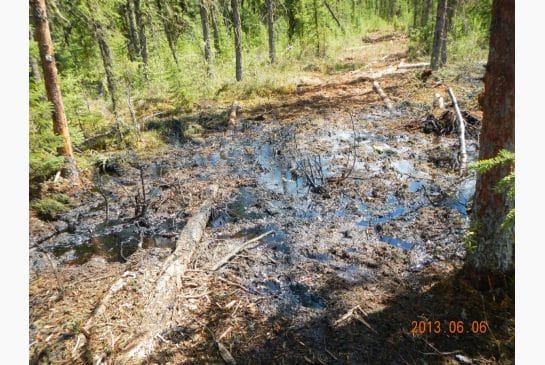Tar sands oil has been spilling in Alberta’s boreal forests for months, and according to a government scientist, neither industry nor government knows how to stop it. Four “oil blowouts” left 34 tons of vegetation covered in oil, dozens of animals dead, and two-foot-high coats of oil on tree trunks.
So far, cleanup efforts have removed 26,000 barrels of bitumen mixed with surface water – at least 4,500 barrels of pure bitumen in total. The impacts on groundwater are unknown.
First reported in the Toronto Star (with photos) and Mother Jones, the information was leaked by a Canadian government scientist who wished to remain anonymous for fear of losing his job.
“Everybody (at the company and in government) is freaking out about this. We don’t understand what happened. Nobody really understands how to stop it from leaking, or if they do they haven’t put the measures into place.”
The spills are located at Canadian Natural Resources, Ltd.’s Primrose bitumen emulsion site in Cold Lake, Alberta. Two of the underground spills began in May, but the Alberta Energy Regulator kept the information silent for nine weeks. A third spill, reported on June 8, is believed to have been leaking for months. None of the previous three spills were reported to the public until the fourth spill on July 18.
So far, the scientist says, the best guess is that the ‘in situ’ steam extraction method used “created fractures from the reservoir to the surface that they didn’t expect.” According to Mother Jones, the site extracts about 100,000 barrels of bitumen from the ground daily through steam injection. Bitumen normally has a peanut-butter-like consistency. The pressurized steam is used to heat and loosen the product so it can be pumped out of the ground.
Keith Stewart, an energy analyst with Greenpeace quoted in the Toronto Star, says the particular steam extraction method used at the Primrose site pressures the oil bed until it blows out. Until the well is no longer pressurized – which could take months – the bitumen will continue to seep from the ground.
Canadian Natural Resources, Ltd., (CNRL) sent Mother Jones a prepared statement:
“The areas have been secured and the emulsion is being managed with clean up, recovery, and reclamation activities well underway. The presence of emulsion on the surface does not pose a health or human safety risk. The sites are located in a remote area which has restricted access to the public. The emulsion is being effectively cleaned up with manageable environmental impact. Canadian Natural has existing groundwater monitoring in place and we are undertaking aquatic and sediment sampling to monitor and mitigate any potential impacts. As part of our wildlife mitigation program, wildlife deterrents have been deployed in the area to protect wildlife…We are investigating the likely cause of the occurrence, which we believe to be mechanical.”
In 2012, CNRL had 18 reportable spills and 18 confirmed well casing failures.
The accidents and the company’s statement come amidst two new reports raising concerns about Alberta’s regulatory ability. The reports include the draft “Environmental Incidents in Northeastern Alberta’s Bitumen Sands Region, 1996 – 2012,” and Newspaper Canada’s annual Freedom of Information Audit.
“Environmental Incidents” found 99% of Alberta’s environmental regulations resulted in zero fines, and Newspaper Canada gave the government of Alberta a transparency grade of ‘D’ for failure to fully disclose information on potentially illegal donations.
According to “Environmental Incidents” report authors Dr. Kevin Timoney and Peter Lee, less than 40 of 4,000 environmental violations committed in Alberta resulted in fines or other actions. Over the last 16 years, the median fine for environmental infractions was $4,500.
Subscribe to our newsletter
Stay up to date with DeSmog news and alerts







